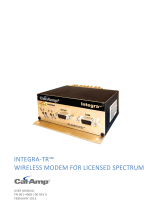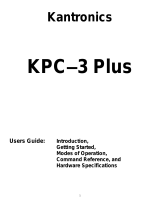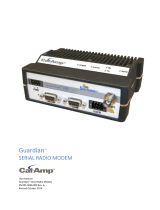Page is loading ...

©1995 Hamtronics, Inc.; Hilton NY; USA. All ri
g
hts reserved. Hamtronics is a re
g
istered trademark. Revised: 4/29/04 - Pa
g
e 1 -
FUNCTIONAL DESCRIPTION.
The CWID-2 is a miniature module
for generating Morse code identifica-
tion for radio repeaters, radio bea-
cons, and similar applications. It
provides an audio output tone of ad-
justable level, normally to a compati-
ble COR board in a repeater, which
mixes the tone in with the receive au-
dio for application to a transmitter.
The CWID-2 offers many advan-
tages over the old popular CWID
module it replaces. It uses very low
current consumption CMOS logic;
current consumption is only 3 mA.
An EPROM, factory programmed by
computer, is used in place of the older
diode matrix to reduce assembly time,
eliminate sources of wiring errors, and
allow longer messages. Many adjust-
ments have been eliminated and re-
placed by preset circuits for ease of
installation; however, resistor values
can be modified to make changes if
desired. The CWID-2 is less than
1/4th the size of the earlier CWID
module, draws 1/60th the current,
and costs less, too!
FEATURES
Adjustable output level up to 700 mV p-p.
Ground pulse to trip, easily be adapted for logic
hi trip input.
Messages up to 2048 bits – enough for up to
200 characters.
Convenient solder terminals for all connections
+5V logic ID KEY output to key COR board.
Can repeat message continuously for beacon
operation.
Power consumption: 7-15V @ only 3 mA.
Size: 1-3/4 x 3-1/8 inches.
ASSEMBLY.
Construction Methods.
Assembly is relatively straight for-
ward. Use the parts list and compo-
nent location drawing as guides.
During construction, orient the board
right side up as shown in the compo-
nent location diagram. The top is the
side without the "Hamtronics" logo.
Precautions.
Note that the ic's are static sensi-
tive. The warranty does not cover
static damage; so handle them with
care. Leave them in their protective
carriers until assembly is done; and
then plug them in, using suitable
static handling precautions. A
grounded wrist strap should be worn
whenever cmos parts are handled.
Even after assembly, it is possible to
damage cmos parts if static builds up
from walking or sliding a chair on a
carpet, etc. Always use precautions
when handling a board with cmos
parts.
The EPROM is light sensitive; ex-
cessive exposure to sunlight or even
strong room light eventually may
erase the chip. Normally it is not nec-
essary; but if you expect the chip to
be exposed to strong light, cover the
window on the EPROM with a sticker
of some sort.
The pc board uses plated-through
holes; so only the bottom of the board
needs to be soldered. Because it is
more difficult to remove parts from
plated-through holes, be sure parts
are correct before soldering. Traces
are close together; so use a fine tip on
the soldering iron.
Assembly Procedure.
a. Install ic sockets. All sockets
should have notch pointing toward
top of board. Solder leads carefully to
prevent solder shorts.
b. Install voltage regulator U1, ori-
enting as shown.
c. Install potentiometer R4.
d. Install all capacitors, observing
polarity on electrolytics.
e. Install all resistors. On verti-
cally-mounted parts, the body of the
part is indicated by a circle on the
diagram.
f. Install the 6 diodes, observing
polarity. The banded (cathode) ends
must be oriented as shown.
g. Check over construction to be
sure all parts are installed in proper
places, with proper polarities, and
check solder connections for any cold
solder joints, solder splashes, etc.
h. Using suitable static protection
described earlier, carefully unpack the
ic's and install them in the sockets.
Be sure to orient them with notches
pointing up. If any conflict between
notches and dots on an ic, the notch
(which only appears on one end) takes
precedence.
Be careful that all the pins actually
go into the sockets. It is easy for
some to bend underneath or extend
over the outside of the socket. Note
that ic's made by Motorola have one
extra digit in the part number, e.g.,
MC14584 instead of 4584.
INSTALLATION.
Mounting.
The CWID-2 module has holes in
the four corners to accommodate 4-40
mounting screws. Normally, threaded
aluminum standoffs (not supplied)
should be used to mount the board to
the repeater chassis to provide a
ground connection.
Wiring.
The CWID-2 board uses plated
through holes, and the terminal pads
around the edge of the board are spe-
cially designed to allow easy solder
connection of cable harness wires go-
ing to the rest of the repeater. The
holes are oversize; so the wires can be
easily inserted even after the holes are
filled with solder.
The easiest way to attach wires is
to strip them about 1/4 inch. Then,
bend a small "Z" in the end of the wire
so that it stays in the hole until sol-
dered. In this way, you can install
many wires and solder them all at
once.
An alternate method is to preload
all the terminal pads with solder.
Then, melt the solder at each pad
when the wire is inserted. This latter
method requires care that solder and
flux remains in good condition until
the wire is bonded to avoid cold solder
joints.
Terminal Functions.
Following is a general description
of the function of each terminal, along
with expected signal voltages.
Terminal E1 is the input terminal
for +7 to 15 Vdc from the power sup-
ply.
Terminal E2 provides a ground
connection to the board. If the board
is mounted to the chassis with metal
standoffs, a separate ground connec-
tion at E2 is not required.
Terminal E3 provides the audio to
HAMTRONICS
®
CWID-2 MODULE:
ASSEMBLY, INSTALLATION, & MAINTENANCE

©1995 Hamtronics, Inc.; Hilton NY; USA. All ri
g
hts reserved. Hamtronics is a re
g
istered trademark. Revised: 4/29/04 - Pa
g
e 2 -
the COR module in the repeater or to
the microphone input of the exciter for
installations other than a repeater,
such as a beacon station. The output
of the CWID-2 module is filtered to
provide a sine wave signal, and poten-
tiometer R4 allows the level to be ad-
justed from 0 to about 700 mV p-p.
Your COR module may also have a
level control.
For some applications, you may
want to install a resistor in series with
the audio output to reduce the level so
audio level potentiometer R4 does not
have to be turn down close to the end
stop. This would be necessary only in
applications where the exciter or other
target module required a very low au-
dio input level.
Terminal E4 is the input for the
ID Trip signal from the COR module.
This should be a ground pulse to trip
the id cycle. In a typical COR module,
such as our COR-3, this ground pulse
is generated right after the courtesy
beep. The CWID-2 module has a
timer, and the id occurs only when
the timer expires, even if the ID Trip
signal is applied. Therefore, although
the ID Trip signal is applied each time
the repeater receiver squelch closes,
the id is generated only once every 9½
minutes and only when there is activ-
ity on the repeater.
Terminal E5 is the ID Key output
from the CWID-2 module when the id
is running. This is a +5V logic level,
which is applied to the COR module to
keep the transmitter keyed when the
id occurs.
Terminal E6 is used only for test-
ing. Applying a ground to E6 forces
the id, regardless of the state of the
timer.
EPROM.
EPROM U4 is light sensitive. Ex-
cessive exposure to sunlight or even
strong room light eventually may
erase the chip. Normally it is not nec-
essary; but if you expect the chip to
be exposed to strong light, cover the
window on the EPROM with a sticker
of some sort.
We can provide a replacement
EPROM, programmed with any mes-
sage you want, for $30. If you need to
order, please specify clearly how it is
to be programmed, and specify that it
is for model CWID-2.
BEACON STATION OPTION.
Spaced Beacon Mode.
To allow the module to be used to
generate an id each time the timer ex-
pires for a beacon station, simply wire
ID Trip terminal E4 to permanent
ground (instead of a ground pulse).
The interval between id transmissions
can be adjusted by changing the value
of R12/R13 as described later.
Note that, since the id is initiated by
the normal reset signal, the first id will
not occur until after the first timer pe-
riod expires (approx. 9½ minutes).
If you want to keep the carrier on
the air only during the periodic id, the
ID Key logic output signal on E5 can
be used to turn on a small signal npn
transistor, which can turn on a larger
pnp transistor to switch the B+ for
one stage of the exciter.
Continuous Beacon Mode.
To make the cwid repeat continu-
ously, with no pause between id's
other than that ordinarily pro-
grammed in eprom, disconnect CR3.
That disables the timer. Then, remove
R10.
Carrier Keying Instead Of Audio
Tone.
The beacon operation described
above assumes you are using the
keyed audio tone output to modulate
the transmitter. If you need to key
the carrier instead, the dc data output
signal at the junction of R2, C5, and
CR2 can be used to key a switching
transistor on and off. This signal
should be applied to the base of small
npn transistor with the emitter tied to
ground. The collector can be used to
key another larger pnp transistor to
key the B+ to one stage of the trans-
mitter. If you wish, U2-A can be used
as a buffer if R3, C6, and C7 are re-
moved.
ADJUSTMENTS.
General Information.
In the interest of keeping the mod-
ule small and easy to install, there is
only one adjustment pot on the board,
audio output level control R4. All
other parameters are preset by fixed
component values. However, there
are provisions to change all of the pa-
rameters if the default conditions are
not suitable for your application.
Cw Tone.
The cwid tone, generated by audio
oscillator U2-A, may be adjusted by
changing the value of either R3 or C6.
Making either value larger lowers the
tone, and smaller values raise the
tone frequency.
Cw Speed.
Cw speed is fixed at about 15
wpm, which is the speed most com-
monly used on repeaters. The speed
is determined by R1/C4 in clock cir-
cuit U2-F. If you prefer a speed a lit-
tle slower, you can increase the value
of R1, and you can decrease the value
of R1 to speed up the code.
Cw Interval.
The length of time between id's is
determined by cwid interval timer
U2-D, and it is normally about 9½
minutes. The interval is set by
R12/R13/C11. Two resistors are
used in series to make it easier to
change in small increments. The in-
terval may be made shorter by de-
creasing the value of resistance, and
may be made longer by increasing the
resistance. However, there is a practi-
cal limit to how much resistance is
used to lengthen the time period. Too
much resistance might result in the
timer never timing out because the re-
sistance is larger than the leakage re-
sistance in the electrolytic capacitor.
If you need a very long time period,
you may need to change to a tantalum
capacitor.
THEORY OF OPERATION.
Refer to the schematic diagram.
The cwid sequence is controlled by
timer U2-E, inverter U2-D, and latch
U2-B/C. When a ground pulse is ap-
plied to U2-D through E4 and R7, the
inverter responds by setting the latch
unless the timer has not timed out. If
the timer is still running, a logic hi is
applied through CR3 to prevent the
latch from being set.
Timer U2-E normally has a logic hi
output while running and its output
goes lo when the timer has completed
its time sequence, which normally
takes about 9½ minutes. The time in-
terval is controlled by the time con-
stant of R12/R13/C11. When the
time sequence begins, C11 starts
charging up slowly through the resis-
tors. When the voltage reaches the
threshold at which U2-E turns off,
U2-E flips to the "ready" state and
stays there until after the id message
is played back. Then, at the end of
the message, the latch is reset, and
capacitor C11 is discharged quickly
through R11 and CR4 to await a new
playback cycle to be tripped. While
the latch is set, a logic hi is applied

©1995 Hamtronics, Inc.; Hilton NY; USA. All ri
g
hts reserved. Hamtronics is a re
g
istered trademark. Revised: 4/29/04 - Pa
g
e 3 -
through the ID Key output at E5 to
the COR board to hold the transmitter
on the air.
EPROM U4 is organized as 8 bits x
4K. We only use bits 0 and 7. The cw
message is stored as sequential Morse
code elements on bit 0 of each byte.
Bit 7 is used to reset the cwid run en-
able flip-flop at the end of the mes-
sage.
The cwid message is recorded in
the EPROM as a series of logic hi's
and lo's on bit 0 of each byte of mem-
ory. Bit 7 is normally lo and has a
logic hi on several bytes after the end
of the id message to reset the timer.
The counter is reset to the first ad-
dress by the latch when the id se-
quence begins. The sequencing of the
eprom message is controlled by ripple
counter U3, clocked by U2-F.
The cw tone is generated by audio
oscillator U2-A, using R3 and C6 to
set the tone frequency. The cw mes-
sage, in binary form, is used to key
the id tone by blocking oscillation
through CR1 when the logic level is lo.
The cwid tone from the oscillator is a
square wave, but it passes through a
low-pass filter (R5/C8/R6/C9), which
converts the square-wave signal to
almost a sine-wave.
Up to 2048 bits of cw data can be
stored in the utilized address range of
A0-A10. The limit on the length of the
message which this
much memory will ac-
commodate depends
on the Morse code el-
ements needed for
each character, but it
is approximately 200 characters.
TROUBLESHOOTING.
Procedures.
The best way to troubleshoot is to
trace signals from stage to stage to
check the operation of each circuit,
starting with the function you believe
is not working properly.
Digital circuits have signal levels
near ground for a lo logic level and
near +5V for a hi logic level. On the
schematic diagram, a small pulse
symbol next to the line indicates if the
signal goes hi or lo during the active
condition. This helps to keep the
sense of the signal clear in your mind
as you glance through from one cir-
cuit to the next.
The most common troubles in all
kits are interchanged components,
cold solder joints, and solder
splashes. Another common trouble is
blown ic's due to reverse polarity or
power line transients.
Current Drain.
Current drain is relatively low, only
about 3 mA. If the module is drawing
a relatively large amount of current,
one or more ic's may have been dam-
aged. If any of the ic's are quite warm
or hot, they may be damaged (by a
transient, reverse polarity, etc.)
CWID-2 PARTS LIST.
Ref Desig Description (marking)
C1-C2 47µf electrolytic
C3 .01µf disc (103)
C4 1µf electrolytic
C5 .01µf disc (103)
C6 .0022µf (2n2K or 2.2nK)
C7-C9 .01µf disc (103)
C10 .001µf (102, 1nM, or 1nK)
C11 470µf electrolytic
CR1-CR6 1N4148 silicon diode
R1 27K
R2 100K
R3 2 meg
R4 20K or 22K trim pot
R5-R7 27K
R8 510K
R9-R10 27K
R11 1.2K
R12 510K
R13 1 meg
U1 78L05 voltage regulator
U2 4584B schmitt trigger
hex inverter
/
static sensitive
U3 4020B binary ripple
counter
/
static sensitive
U4 27C32 eprom
/
static sensitive
COMPONENT LOCATION DIAGRAM
FIGURE 1. CWID-2 MODULE,
1
7 8
14
MTG
1
8 9
16
_ + MTG MTG
MTG
1
12 13
24
R4
Level
+
_
C11
_ +
_
+
U3 - 4020
U2- 4584
U4 - 27C32
E1 +12V E2- GND E3 AF OUT
E4 - ID TRIP E5 - ID KEY E6 - TEST
C1
C2
C3
C4
C5
C6
C7
C8
C9
C10
CR5
R5
R6
R8
R1
R3
CR3
CR4
R13 R12
R11
R7
CR2
CR1
R10
R9
R2
U1
CR6

©1995 Hamtronics, Inc.; Hilton NY; USA. All ri
g
hts reserved. Hamtronics is a re
g
istered trademark. Revised: 4/29/04 - Pa
g
e 4 -
FIGURE 2. CWID-2 MODULE,
SCHEMATIC DIAGRAM
E1
E2
+13.6 VDC
GND
U1
78L05
C1 C2 U2 U3
7
7
14 16
C3
U3 U4
4584 4020 27C32
8
24
12
+
_
U3 - 4020
10
CL
11
RST
Q4
Q5
Q6
Q7
Q8
Q9
Q10
Q11
Q12
Q13
Q14
7
5
4
6
13
12
14
15
1
2
3
8
7
6
5
4
3
2
1
23
22
19
A0
A1
A2
A3
A4
A5
A6
A7
A8
A9
A10
U4 - 27C32
A11
OE
21
20
CE EOM
17
O7
O0 9
DATA
12
AUDIO OUTPUT
E3
E2
E4
ID TRIP
+5V
56 98
11 10
E6
TEST
EOM
LATCH
+
_
+
_
INVERTER
9-MIN. TIMER
34
TIMING
READY
+
_
+5V
OSC INHIBIT
8 MSEC
E5
ID KEY
SET
RESET
U2-B
U2-CU2-D
U2-F
13 12
CLOCK
AUDIO OSC
U2-A
R4
AUDIO LEVEL
U2-E
700 mV P-P MAX
18
C4
R1
R2
C5
CR1
CR2
C6
R3
C7
R6R5
C8 C9
R8
R7
CR3
C10
CR5
R9
R10
R11
R12 R13
C11
CR6
CR4
/




